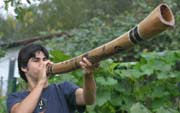WHAT IS THE DIDGERIDOO?
The didgeridoo is, without doubt, one of the oldest instruments in the world (over 40,000 years old) and comes from the culture of the Australian aborigines.
It is basically a trunk hollowed out naturally by termites, which produces a deep sound when blown through. No two didgeridoos are the same. Each has its own particular sound.
The trunk measures between 1.5 and 2 metres with a diameter of 2 to 5 cm.
The aborigines use didgeridoos in their songs, rituals and celebrations as a musical instrument. Some people sing and play wooden percussion instruments, while others play the didgeridoo.
The instrument has an endless list of different names: Yidaki is the best known and most commonly used among the aborigines, although it is also called Djalupu and Maluk.
Although originally didgeridoos were made from eucalyptus wood, nowadays they are made from other materials in a number of different styles, including plastic (PVC), bamboo, teak, pita, glass and many different types of wood. Obviously, these new-style didgeridoos are not hollowed out by termites, but rather using a lathe, although in the case of bamboo, the hollow is natural.

